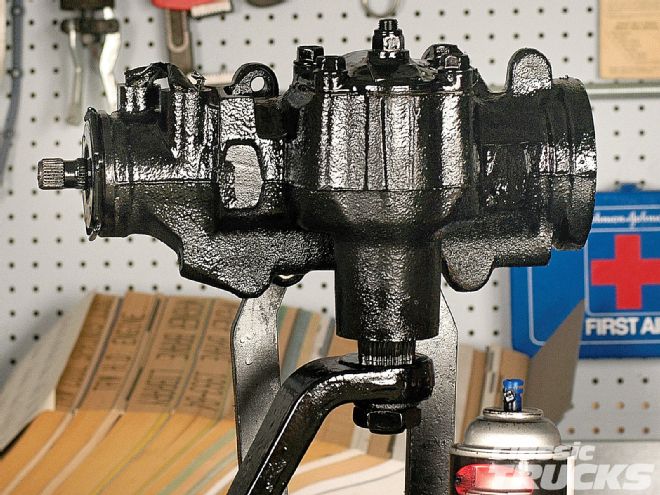
By 1951, many American vehicles required power steering. Gemmer's Hydraguide system, the first power steering system used on an American car, was Chrysler's answer to the massive front end weight created by the new hemi V-8. Other manufacturers quickly followed.
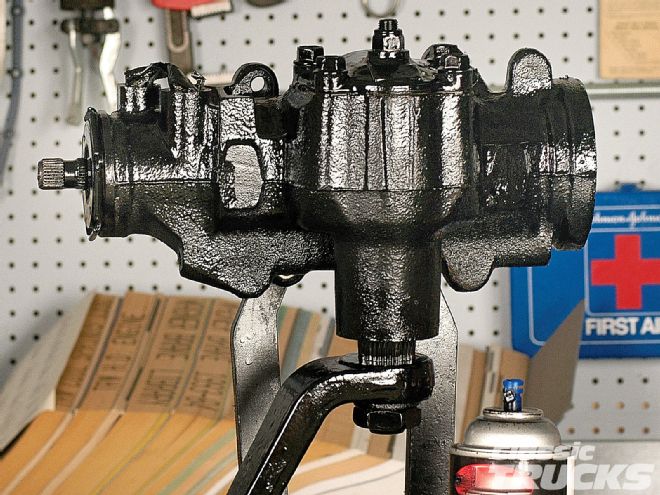 The Saginaw rotary valve steering gear is an integral, streamlined design introduced in 1959. By the end of the '60s, all GM cars and light trucks offered this gear. Ford, I-H, Dodge, and Jeep outsourced rotary valve gears as well. Saginaw's recirculating ball-and-rack piston engineering has become a worldwide standard.
The Saginaw rotary valve steering gear is an integral, streamlined design introduced in 1959. By the end of the '60s, all GM cars and light trucks offered this gear. Ford, I-H, Dodge, and Jeep outsourced rotary valve gears as well. Saginaw's recirculating ball-and-rack piston engineering has become a worldwide standard.
Two power steering designs emerged. Linkage assist steering and the integral power steering gear-each use a constant flow, positive displacement hydraulic pump. The pump, belt-driven by the engine, pressurizes and circulates power steering fluid.
Linkage assist steering consists of a hydraulic control valve attached to one end of the drag link or centerlink. The valve receives input signals from the steering wheel and steering gear. Left or right steering causes the valve to react, opening ports to move hydraulic fluid into a hydraulic ram. The ram attaches to the steering linkage. Fluid directed to one side of the ram's piston or the other determines which direction the power assist will apply.
The linkage assist system is the easiest to adapt. Some truck manufacturers made power assist kits available for dealer installation. The kits worked with the existing manual steer gear and included a drag link and control valve assembly, the hydraulic power ram, a power steering pump with brackets, and the pressure and return hoses.
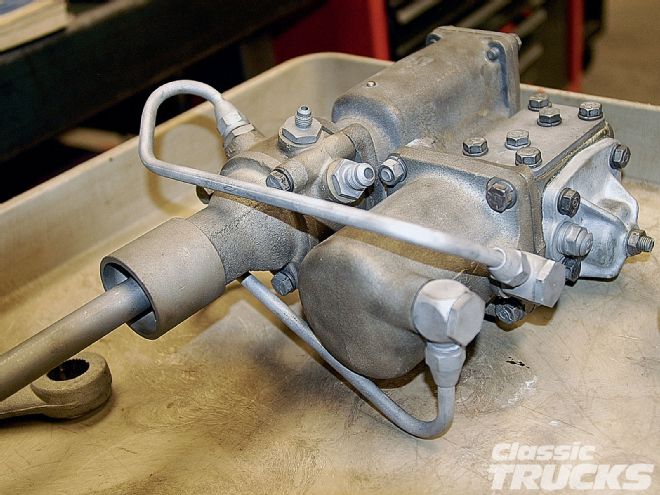 This apparatus is a Saginaw offset integral steering gear. Introduced in 1952 GM luxury models, the design preceded Saginaw's inline gear. Like the Gemmer Hydraguide, the offset was essentially a manual steering gear with a parallel power assist cylinder and rack drive. The unit was too large for light truck, ladder frame use.
This apparatus is a Saginaw offset integral steering gear. Introduced in 1952 GM luxury models, the design preceded Saginaw's inline gear. Like the Gemmer Hydraguide, the offset was essentially a manual steering gear with a parallel power assist cylinder and rack drive. The unit was too large for light truck, ladder frame use.
Linkage power steering makes use of the manual steering gear. On a beam axle model, the control valve attaches to the drag link. The power cylinder's ram end attaches to the tie rod. An anchor bracket supports the cylinder end. For independent front suspension like the '60-66 GM trucks, the control valve attaches to the centerlink at the pitman arm end. Apply pressure is controlled by the valve settings and pump input pressure.
The significant downside to linkage power steering is its vulnerability to damage. The power ram and hoses are continually exposed to the elements, road obstacles and debris.
Integral Power Steering Gears
Modern light trucks use integral power steering. Integral power gears include the control valve, apply piston, and gear system. The assembly mounts to the frame at the same location as a manual steering gear. A pitman arm delivers power from the gear to the steering linkage in the same manner as a manual steering gear.
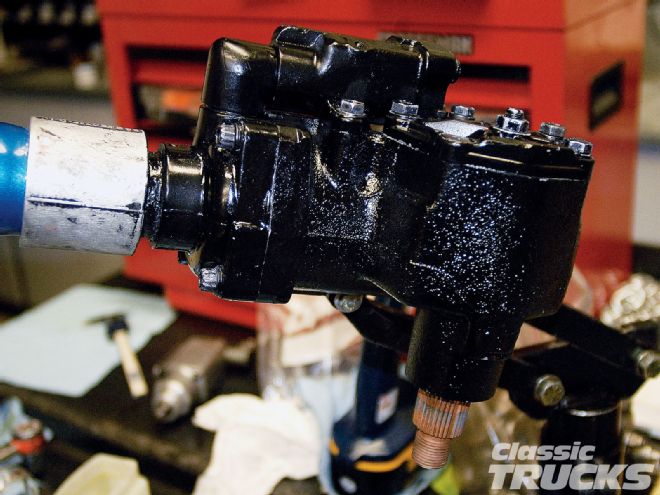 Saginaw's inline integral steering gear came online in 1956. A compact unit, the inline became a GMC light truck option. Despite use on luxury GM cars and the GMC trucks, there were weaknesses in the design. GM phased out the inline within four years of its introduction. The better inline features carry forth to the rotary valve steering gear.
Saginaw's inline integral steering gear came online in 1956. A compact unit, the inline became a GMC light truck option. Despite use on luxury GM cars and the GMC trucks, there were weaknesses in the design. GM phased out the inline within four years of its introduction. The better inline features carry forth to the rotary valve steering gear.
Light truck power steering came directly from automotive applications. The earliest integral automotive designs were contraptions, a complex melding of manual gear technology and power pistons. Fortunately, Gemmer's Hydraguide and Saginaw's offset applications never made the light truck option list. These designs were cumbersome, taxed horsepower and ate up engine bay space-undesirable traits for a ladder-frame truck.
GM's Saginaw Division eventually developed the most reliable, widely used integral power steering gear in the industry. Rotary valve steering first appeared in 1959 Cadillac, Pontiac, Buick, and Oldsmobile cars. By the late 1960s, all passenger cars and the Chevrolet and GMC light trucks used this gear. Saginaw's rotary valve gears found their way into Ford, Dodge, I-H, and Jeep trucks. Some features of the gear could also be seen in Ford's torsion bar and Chrysler's constant control integral power steering.
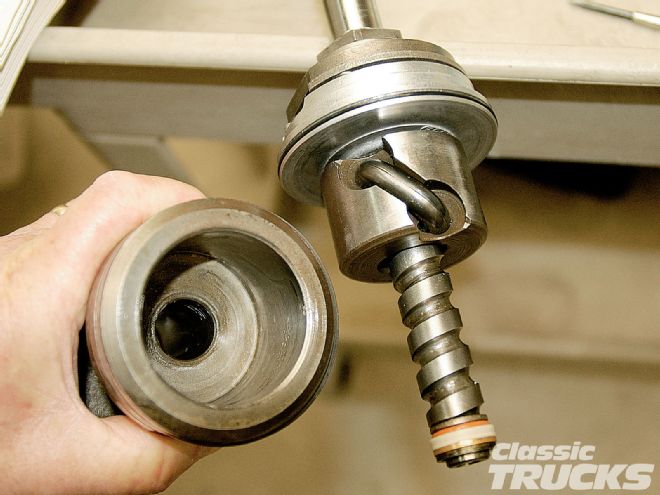 Saginaw's inline introduced the recirculating ball nut-and-worm power rack piston. In this design, the ball nut and rack piston are separate pieces. During assembly, the ball nut (shown at right) is secured within the rack piston (left) by a tapered set screw. On the subsequent rotary valve design, the ball nut and rack piston is a single, machined piece.
Saginaw's inline introduced the recirculating ball nut-and-worm power rack piston. In this design, the ball nut and rack piston are separate pieces. During assembly, the ball nut (shown at right) is secured within the rack piston (left) by a tapered set screw. On the subsequent rotary valve design, the ball nut and rack piston is a single, machined piece.
The predecessor to rotary valve integral power steering was Saginaw's inline design. Standard for Cadillac and optioned on Buick, Pontiac, and Oldsmobile passenger cars in 1956, the inline gear introduced several innovative features. Unlike the Saginaw offset design, the inline gear could be fitted within a tighter engine bay or into a light truck chassis.
While Chevrolet opted for less expensive linkage power steering on its '55-64 passenger cars and light truck models, GMC Division took a bold initiative that reflected its upscale image. Pontiac became GMC's V-8 engine source for '55-59 pickups. Since Pontiac cars used the inline gear, the GMC V-8s could be readily fitted with a power steering pump. Late '50s GMC 100-300 series models added inline power steering to the option list and became the first trucks to offer integral power steering.
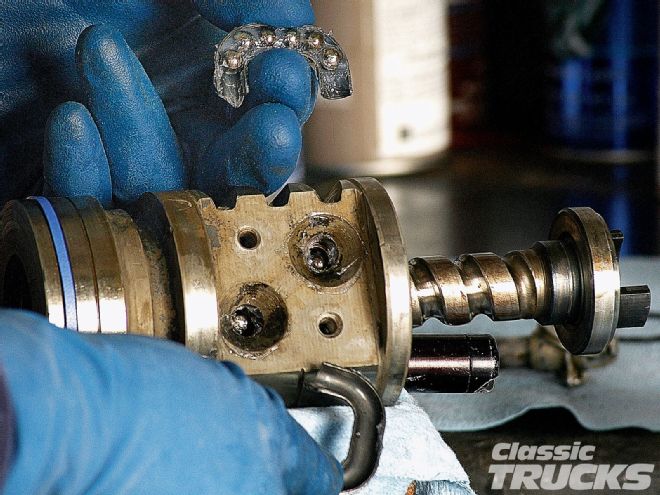 Saginaw rotary valve 800 and 808 steering gears are common to light GM trucks and other applications. Unlike the inline gear, the rack piston and worm outer ball bearing is one piece. During overhaul, balls load into the piston rack, winding their way around the worm shaft. This design distributes loads evenly between the rack piston and worm.
Saginaw rotary valve 800 and 808 steering gears are common to light GM trucks and other applications. Unlike the inline gear, the rack piston and worm outer ball bearing is one piece. During overhaul, balls load into the piston rack, winding their way around the worm shaft. This design distributes loads evenly between the rack piston and worm.
Power Steering Service
Wear and fatigue points on linkage assist steering include the hoses, hydraulic ram cylinder, the control valve, and the power pump. Drivebelt adjustment and replacement are routine service requirements for any power steering system.
The manual steering gear on a linkage power steering system seldom wears. It receives far less load, since the linkage moves under hydraulic pressure. Minor adjustment might be necessary at higher mileage, but unless the hydraulic assist is defective, load wear should be minimal. Fluid levels for the pump and manual gear require periodic checks and topping off. Use gear lube in the manual steering gear and recommended ATF or power steering fluid in the power pump.
Saginaw's 700, 708, 800, and 808 integral gears are extremely rugged. Chrysler constant control and Ford torsion bar integral gears also hold up well. Weaker designs would be the Saginaw 605, which is prone to failure at higher mileage. Due to its compact size, the 605 has been a popular retrofit on street rods and some vintage trucks. The 605 integral-type steering gear does not match the stamina of larger rotary valve designs.
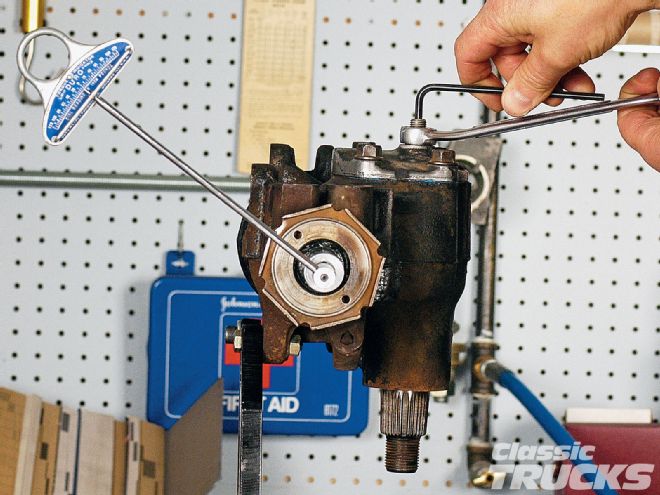 New bearings and seals restore an 800 gear. Adjustments follow factory steps. Similar to a manual gear, the two concerns are worm bearing preload and over-center mesh load at the sector teeth. Adjustment begins with the worm bearings. Tool required is an in/lb torque wrench. Final setting (shown) is over-center rack tooth and sector mesh.
New bearings and seals restore an 800 gear. Adjustments follow factory steps. Similar to a manual gear, the two concerns are worm bearing preload and over-center mesh load at the sector teeth. Adjustment begins with the worm bearings. Tool required is an in/lb torque wrench. Final setting (shown) is over-center rack tooth and sector mesh.
The 700- and 800-series gears have a 70mm piston bore. The 708 and 808 gears benefit from an 80mm bore. The 605 uses a 66.6mm piston, and it does not use a four-bolt cover plate at the adjuster end. Instead, the adjuster/cover plate is a thick cup washer retained by a snap ring. The 605 suits light-duty vehicles like the original S-trucks and some passenger cars. There is a contemporary Saginaw 600-series gear with a 70mm bore and the model 608 gear with an 80mm bore. The modern 600 series has stamina and even NASCAR applications to its credit.
The larger Saginaw rotary valve gears require little attention. The pump will likely fail long before a gear shows wear. Pitman/sector or worm bearing adjustment is seldom necessary between rebuilds. Slight backlash or worm play can be corrected if necessary. Significant worm play, over-center backlash, or any roughness indicate the need for rebuilding.
Hoses are a wear point. On integral systems, there is less movement of hoses, and they are protected within the engine bay. Linkage assist hoses spend a lifetime stretching and flexing as the ram and steering linkage move back and forth. Inspect hoses for nicks, abrasion, deterioration and oil damage. Pressure in the hydraulic system is high, and heat contributes to hose failure. If a fatigued hose sloughs rubber internally, the debris can damage sensitive valves within the power gear and pump.
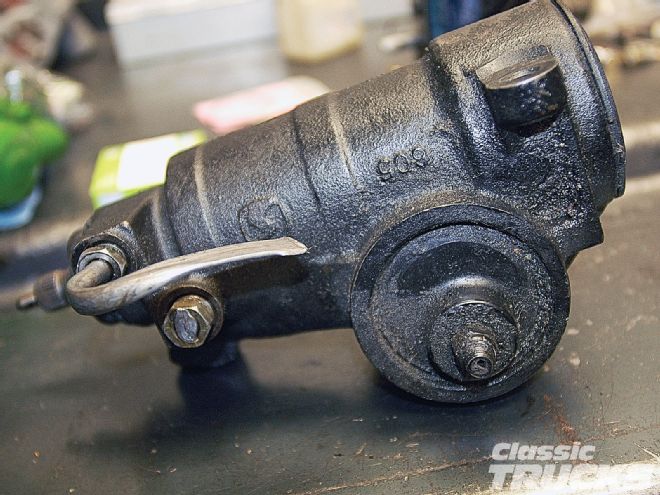 Saginaw 605 gear has become popular for tight-space conversions. This gear is lighter duty than the 700- and 800-series designs. If you select a 605 for your conversion, do not bother with a recycled unit. There is no such thing as a "good used" Saginaw 605. A better bet is a quality rebuild from a reputable source or an 800/808 or 700/708 gear.
Saginaw 605 gear has become popular for tight-space conversions. This gear is lighter duty than the 700- and 800-series designs. If you select a 605 for your conversion, do not bother with a recycled unit. There is no such thing as a "good used" Saginaw 605. A better bet is a quality rebuild from a reputable source or an 800/808 or 700/708 gear.
Service Cautions
A power steering system is much like an automatic transmission. Passageways and valves are close-tolerance and subject to clogging and scoring. Prevent debris from entering the system. Use the recommended fluid. On an older truck that has set up for a long period, flush the system with fresh fluid.
When performing fluid checks or working on the power steering system, protect the pump, hoses and gear assembly from debris. Use the recommended fluid, often Type A or its modern Dexron/Mercon equivalent. If leaks develop at the steering gear or linkage, do not allow the system to run dry. Inspect the pump, hoses and gear seals for signs of seepage.
Rebuilding a pump, control valve, or integral power gear is a responsible job. Before attempting this work, consult the factory shop manual. Be certain you have the right tools and experience for performing work on the steering system.
Note: Steering and suspension are safety areas of your truck. Follow factory guidelines and shop procedures when working on your vehicle's steering system.
What Did You Learn This Month?
Night School would not be complete without a quiz! Don't worry about your test-taking skills or grades. This is an open-magazine, true or false test. Clues can be found within the Night School text, photos and captions. Have a good month!
True or False Questions:
1. Heavier engines and bigger car bodies made power steering a necessary option.
2. Saginaw's offset steering gears were compact and well-suited for light truck use.
3. GMC was the first American truck brand to use an integral power steering gear. The design was Saginaw's inline type.
4. Linkage-type power steering was easily adapted to beam axle trucks. Some manufacturers offered linkage assist power steering retrofit kits.
5. An integral power steering gear is easy to rebuild. You do not need special tools or a shop manual to restore a power steering gear.
6. The Saginaw inline gear was more compact than the offset design. Many advanced features of the inline carry over to the rotary valve gear.
7. All power steering pumps are the same, and all power steering systems operate at the same pressure. If you need a power steering pump, any one will do.
8. A Saginaw 605 gear is compact and easier to mount in tight-fitting applications. However, the 605 gear does not have the stamina of a Saginaw 808 model.
9. If there is a lot of steering wheel play and a rough feel in an integral power steering gear, an adjustment should fix it. There's no need to disassemble and inspect the unit.
10. During a rebuild, the Saginaw rotary valve gear requires worm bearing adjustment and an over-center rack-and-sector tooth mesh adjustment.
1 True, 2 False, 3 True, 4 True, 5 False, 6 True, 7 False, 8 True, 9 False, 10 True